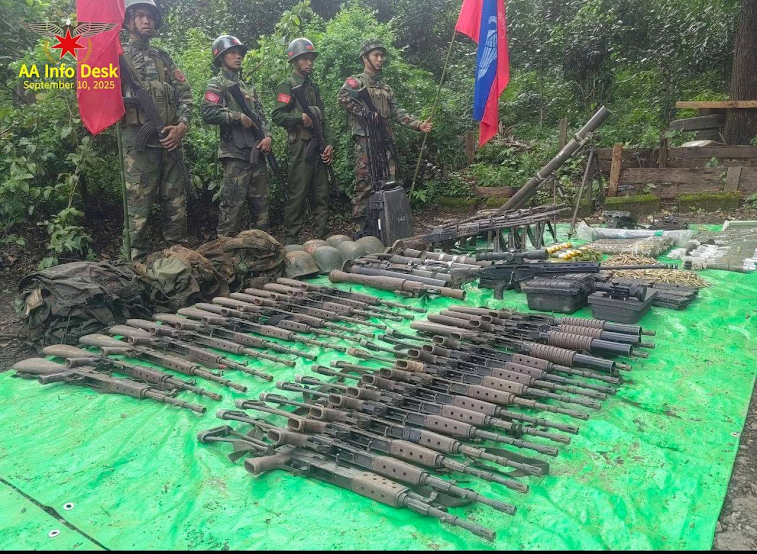Myanmar Spring Chronicle – October 14: Scene
(MoeMaKa, October 15, 2025)
The End of the Gaza War and the Prospects for a Ceasefire and Peace in Myanmar
After two years and three days of relentless warfare, Israel’s military campaign to eradicate Hamas finally came to a halt on October 10, 2025. The operation, which began on October 7, 2023, marked one of the darkest and most brutal chapters in the long-running Israeli–Palestinian conflict.
According to Gaza’s health ministry, Israel’s bombardments and ground offensives have killed over 70,100 Palestinians in the Gaza Strip over that two-year span. Among the dead were 217 journalists, 179 UNRWA aid workers, and nearly 50 staff from other humanitarian organizations. Analysts estimate that around 80% of those killed were civilians, including approximately 20,000 children.
Despite the world witnessing the war in real time — with daily videos, photos, and interviews documenting the destruction wrought by Israel’s airstrikes, artillery, and advanced weaponry — global outrage was not enough to stop the bloodshed.
Mounting International Pressure
In recent months, public opposition inside Israel grew, with protests against the Netanyahu government and its military policies. Some Western European allies of Israel began officially recognizing the two-state solution, and when the Israeli prime minister addressed the United Nations, many diplomats walked out in protest.
While legal and academic experts have defined Israel’s Gaza campaign as genocidal, the Israeli government — supported militarily and financially by the United States and several Western countries — continued its operations for months afterward.
By mid-2025, Israel had imposed a total blockade on Gaza, forcing much of the population to flee or face starvation. Widespread hunger and disease caused increasing civilian deaths, creating a humanitarian catastrophe.
Even at this stage, however, most Western governments continued to back Israel diplomatically. Still, global activists, humanitarian groups, and even some officials in Western governments began expressing moral discomfort. Student movements and solidarity groups organized weekly protests in major cities, while several universities cut institutional ties with Israeli counterparts.
International activists also launched aid flotillas, attempting to deliver food and medical supplies to the besieged enclave. These actions, combined with mounting public protests, finally contributed to pressure that led to a mutual ceasefire.
A Fragile Ceasefire
As of now, both sides have agreed to exchange detainees and hostages and to halt military operations. Whether this ceasefire will hold remains uncertain, but it marks the first pause after two years of devastating war.
For Palestinians — over two million trapped in a territory smaller than many districts of other countries — Gaza remains their sacred homeland, deeply tied to religious faith and ancestral identity. Many refused to flee, enduring unimaginable suffering rather than abandoning their land.
Analysts believe Israel’s hidden objective throughout the war was to pursue the idea of a “Greater Israel”, using Hamas’s October 7 attacks as a pretext to seize more territory and permanently reshape Gaza. As long as this expansionist goal persists, Gaza’s peace will remain fragile and uncertain.
Parallels in Myanmar
Tomorrow, October 15, the military regime in Naypyitaw plans to commemorate the 10th anniversary of Myanmar’s Nationwide Ceasefire Agreement (NCA).
The event will include junta officials, some ethnic armed groups that remain in truce with the military, representatives from pro-junta political parties, and select civil society organizations.
Meanwhile, across Rakhine, Shan, Bago, Ayeyarwady, Karen, Tanintharyi, Sagaing, Magway, Mandalay, Kachin, and Karenni, battles continue daily. Even in areas without open ground fighting, airstrikes, bombings, paramotor, and drone attacks persist.
Myanmar’s civil war — now nearing eight decades old — shows no sign of ending. The 2021 coup reignited long-dormant flames of conflict, and though many hope this fire will ultimately consume the dictatorship, the outcome remains uncertain.
Victory against the military regime will require the ethnic armed organizations (EAOs) and People’s Defense Forces (PDFs) — all fighting under different banners of self-determination — to form a united vision and collective strategy. Only through shared objectives can their struggle bring about the end of Myanmar’s militarized authoritarianism.
Otherwise, the country risks remaining trapped in a cycle of war and false peace talks, where each new “ceasefire” simply resets the clock for the next round of bloodshed.

